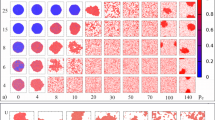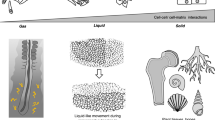Abstract
Cell migration is important in many biological processes, including embryonic development, cancer metastasis and wound healing. In these tissues, a cell’s motion is often strongly constrained by its neighbours, leading to glassy dynamics. Although self-propelled particle models exhibit a density-driven glass transition, this does not explain liquid-to-solid transitions in confluent tissues, where there are no gaps between cells and therefore the density is constant. Here we demonstrate the existence of a new type of rigidity transition that occurs in the well-studied vertex model for confluent tissue monolayers at constant density. We find that the onset of rigidity is governed by a model parameter that encodes single-cell properties such as cell–cell adhesion and cortical tension, providing an explanation for liquid-to-solid transitions in confluent tissues and making testable predictions about how these transitions differ from those in particulate matter.
This is a preview of subscription content, access via your institution
Access options
Subscribe to this journal
Receive 12 print issues and online access
$209.00 per year
only $17.42 per issue
Buy this article
- Purchase on Springer Link
- Instant access to full article PDF
Prices may be subject to local taxes which are calculated during checkout





Similar content being viewed by others
References
Schoetz, E.-M., Lanio, M., Talbot, J. A. & Manning, M. L. Glassy dynamics in three-dimensional embryonic tissues. J. R. Soc. Interface 10, 20130726 (2013).
Angelini, T. E. et al. Glass-like dynamics of collective cell migration. Proc. Natl Acad. Sci. USA 108, 4714–4719 (2011).
Nnetu, K. D., Knorr, M., Käs, J. & Zink, M. The impact of jamming on boundaries of collectively moving weak-interacting cells. New J. Phys. 14, 115012 (2012).
Haxton, T. K., Schmiedeberg, M. & Liu, A. J. Universal jamming phase diagram in the hard-sphere limit. Phys. Rev. E 83, 031503 (2011).
Abate, A. R. & Durian, D. J. Topological persistence and dynamical heterogeneities near jamming. Phys. Rev. E 76, 021306 (2007).
Liu, A. J. & Nagel, S. R. The jamming transition and the marginally jammed solid. Annu. Rev. Condens. Matter Phys. 1, 347–369 (2010).
Vicsek, T., Czirók, A., Ben-Jacob, E., Cohen, I. & Shochet, O. Novel type of phase transition in a system of self-driven particles. Phys. Rev. Lett. 75, 1226–1229 (1995).
Henkes, S., Fily, Y. & Marchetti, M. C. Active jamming: Self-propelled soft particles at high density. Phys. Rev. E 84, 040301 (2011).
Chate, H., Ginelli, F., Gregoire, G., Peruani, F. & Raynaud, F. Modeling collective motion: Variations on the Vicsek model. Eur. Phys. J. B 64, 451–456 (2008).
Berthier, L. Nonequilibrium glassy dynamics of self-propelled hard disks. Phys. Rev. Lett. 112, 220602 (2014).
Berthier, L. & Kurchan, J. Non-equilibrium glass transitions in driven and active matter. Nature Phys. 9, 310–314 (2013).
Petitjean, L. et al. Velocity fields in a collectively migrating epithelium. Biophys. J. 98, 1790–1800 (2010).
Nagai, T. & Honda, H. A dynamic cell model for the formation of epithelial tissues. Phil. Mag. B 81, 699–719 (2001).
Farhadifar, R., Röper, J.-C., Aigouy, B., Eaton, S. & Jülicher, F. The influence of cell mechanics, cell–cell interactions, and proliferation on epithelial packing. Curr. Biol. 17, 2095–2104 (2007).
Hufnagel, L., Teleman, A. A., Rouault, H., Cohen, S. M. & Shraiman, B. I. On the mechanism of wing size determination in fly development. Proc. Natl Acad. Sci. USA 104, 3835–3840 (2007).
Staple, D. B. et al. Mechanics and remodelling of cell packings in epithelia. Eur. Phys. J. E 33, 117–127 (2010).
Hilgenfeldt, S., Erisken, S. & Carthew, R. W. Physical modeling of cell geometric order in an epithelial tissue. Proc. Natl Acad. Sci. USA 105, 907–911 (2008).
Manning, M. L., Foty, R. A., Steinberg, M. S. & Schoetz, E.-M. Coaction of intercellular adhesion and cortical tension specifies tissue surface tension. Proc. Natl Acad. Sci. USA 107, 12517–12522 (2010).
Wang, G., Manning, M. L. & Amack, J. D. Regional cell shape changes control form and function of Kupffer’s vesicle in the zebrafish embryo. Dev. Biol. 370, 52–62 (2012).
Chiou, K. K., Hufnagel, L. & Shraiman, B. I. Mechanical stress inference for two dimensional cell arrays. PLoS Comput. Biol. 8, e1002512 (2012).
Fletcher, A. G., Osterfield, M., Baker, R. E. & Shvartsman, S. Y. Vertex models of epithelial morphogenesis. Biophys. J. 106, 2291–2304 (2014).
Hočevar, A. & Ziherl, P. Degenerate polygonal tilings in simple animal tissues. Phys. Rev. E 80, 011904 (2009).
Zehnder, S. M., Suaris, M., Bellaire, M. M. & Angelini, T. E. Cell volume fluctuations in MDCK monolayers. Biophys. J. 108, 247–250 (2015).
Graner, F. & Glazier, J. A. Simulation of biological cell sorting using a two-dimensional extended Potts model. Phys. Rev. Lett. 69, 2013–2016 (1992).
Amack, J. D. & Manning, M. L. Extending the differential adhesion hypothesis in embryonic cell sorting. Science 338, 212–215 (2012).
Lecuit, T. “Developmental mechanics”: Cellular patterns controlled by adhesion, cortical tension and cell division. HFSP J. 2, 72–78 (2008).
Guillot, C. & Lecuit, T. Mechanics of epithelial tissue homeostasis and morphogenesis. Science 340, 1185–1189 (2013).
Weaire, D. L. & Hutzler, S. The Physics of Foams (Oxford Univ. Press, 1999).
Bi, D., Lopez, J. H., Schwarz, J. M. & Manning, M. L. Energy barriers and cell migration in densely packed tissues. Soft Matter 10, 1885–1890 (2014).
Newhall, K. A., Jorjadze, I., Vanden-Eijnden, E. & Brujic, J. A statistical mechanics framework captures the packing of monodisperse particles. Soft Matter 7, 11518–11525 (2011).
Aste, T. & Di Matteo, T. Emergence of gamma distributions in granular materials and packing models. Phys. Rev. E 77, 021309 (2008).
Bi, D., Zhang, J., Behringer, R. P. & Chakraborty, B. Fluctuations in shear-jammed states: A statistical ensemble approach. Europhys. Lett. 102, 34002 (2013).
Kadanoff, L. P. et al. Static phenomena near critical points: Theory and experiment. Rev. Mod. Phys. 39, 395–431 (1967).
Olsson, P. & Teitel, S. Critical scaling of shear viscosity at the jamming transition. Phys. Rev. Lett. 99, 178001 (2007).
Das, M., Quint, D. A. & Schwarz, J. M. Redundancy and cooperativity in the mechanics of compositely crosslinked filamentous networks. PLoS ONE 7, e35939 (2012).
Broedersz, C. P., Mao, X., Lubensky, T. C. & MacKintosh, F. C. Criticality and isostaticity in fibre networks. Nature Phys. 7, 983–988 (2011).
Heussinger, C. & Frey, E. Floppy modes and nonaffine deformations in random fiber networks. Phys. Rev. Lett. 97, 105501 (2006).
Ashcroft, N. W. & Mermin, N. D. Solid State Physics HRW International edn (Holt, Rinehart and Winston, 1976).
Silbert, L. E., Liu, A. J. & Nagel, S. R. Vibrations and diverging length scales near the unjamming transition. Phys. Rev. Lett. 95, 098301 (2005).
Wyart, M., Silbert, L. E., Nagel, S. R. & Witten, T. A. Effects of compression on the vibrational modes of marginally jammed solids. Phys. Rev. E 72, 051306 (2005).
Manning, M. L. & Liu, A. J. A random matrix definition of the boson peak. Europhys. Lett. 109, 36002 (2013).
O’Hern, C. S., Langer, S. A., Liu, A. J. & Nagel, S. R. Random packings of frictionless particles. Phys. Rev. Lett. 88, 075507 (2002).
Park, J.-A. et al. Unjamming and cell shape in the asthmatic airway epithelium. Nature Mater. http://dx.doi.org/63x (2015).
Sadati, M., Qazvini, N. T., Krishnan, R., Park, C. Y. & Fredberg, J. J. Collective migration and cell jamming. Differentiation 86, 121–125 (2013).
Kasza, K. E., Farrell, D. L. & Zallen, J. A. Spatiotemporal control of epithelial remodeling by regulated myosin phosphorylation. Proc. Natl Acad. Sci. USA 111, 11732–11737 (2014).
Kalluri, R. & Weinberg, R. A. et al. The basics of epithelial–mesenchymal transition. J. Clin. Invest. 119, 1420–1428 (2009).
Gabrielli, A. & Torquato, S. Voronoi and void statistics for superhomogeneous point processes. Phys. Rev. E 70, 041105 (2004).
Torquato, S. & Haslach, H. W. Jr Random heterogeneous materials: Microstructure and macroscopic properties. Appl. Mech. Rev. 55, B62–B63 (2002).
Brakke, K. A. The Surface Evolver. Exp. Math. 1, 141–165 (1992).
Acknowledgements
We would like to thank G. Salbreux and M. C. Marchetti for substantial and useful comments on this manuscript. M.L.M. acknowledges support from the Alfred P. Sloan Foundation, and M.L.M. and D.B. acknowledge support from NSF-CMMI-1334611 and NSF-DMR-1352184. M.L.M. and D.B. also would like to thank the KITP at the University of California Santa Barbara for hospitality, supported in part by NSF PHY11-25915. The authors also acknowledge the Syracuse University HTC Campus Grid and NSF award ACI-1341006.
Author information
Authors and Affiliations
Contributions
D.B., M.L.M. and J.M.S. conceived and designed the project, which was executed and analysed by D.B. and J.H.L., with oversight from J.M.S. and M.L.M. D.B., J.M.S. and M.L.M. prepared the manuscript.
Corresponding author
Ethics declarations
Competing interests
The authors declare no competing financial interests.
Supplementary information
Supplementary information
Supplementary information (PDF 1354 kb)
Rights and permissions
About this article
Cite this article
Bi, D., Lopez, J., Schwarz, J. et al. A density-independent rigidity transition in biological tissues. Nature Phys 11, 1074–1079 (2015). https://doi.org/10.1038/nphys3471
Received:
Accepted:
Published:
Issue Date:
DOI: https://doi.org/10.1038/nphys3471



